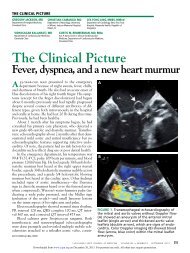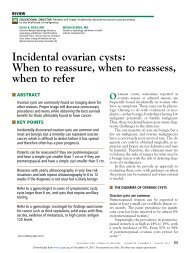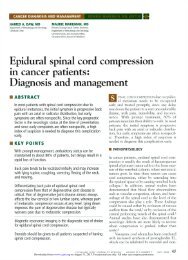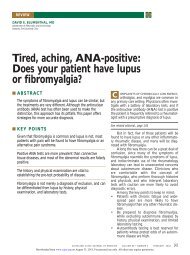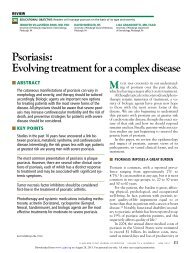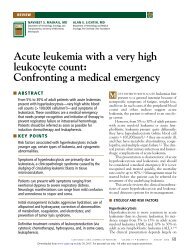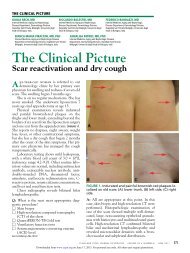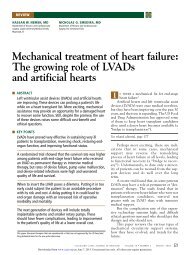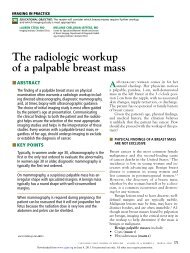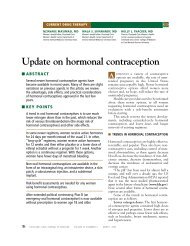Recurrent pregnancy loss: Evaluation and discussion of the causes ...
Recurrent pregnancy loss: Evaluation and discussion of the causes ...
Recurrent pregnancy loss: Evaluation and discussion of the causes ...
Create successful ePaper yourself
Turn your PDF publications into a flip-book with our unique Google optimized e-Paper software.
RECURRENT PREGNANCY LOSS<br />
KIWI<br />
The most<br />
common<br />
inherited<br />
thrombophilic<br />
disorders are<br />
factor V Leiden<br />
<strong>and</strong><br />
prothrombin<br />
G20210A<br />
mutations<br />
<strong>pregnancy</strong> to control lupus activity <strong>and</strong> maximize<br />
<strong>the</strong> chance <strong>of</strong> a successful <strong>pregnancy</strong>. For<br />
patients with recurrent <strong>pregnancy</strong> <strong>loss</strong>, <strong>the</strong><br />
dose should be maintained throughout <strong>the</strong> first<br />
trimester <strong>and</strong> <strong>the</strong>n tapered. Often, patients<br />
with active SLE or with multiorgan involvement<br />
are co-managed by a rheumatologist.<br />
Prednisone has not been shown to be<br />
associated with congenital anomalies in<br />
humans, but intrauterine growth retardation<br />
<strong>and</strong> gestational diabetes may develop in<br />
patients who are maintained on prednisone<br />
throughout <strong>pregnancy</strong>. However, active SLE is<br />
also associated with poor fetal outcome.<br />
■ THROMBOPHILIAS<br />
Patients with an inherited thrombophilia may<br />
have recurrent <strong>pregnancy</strong> <strong>loss</strong> due to coagulopathy,<br />
especially in <strong>the</strong> second or third<br />
trimester. Thrombosis <strong>of</strong> <strong>the</strong> spiral arterioles<br />
in <strong>the</strong> intervillous space may impair placental<br />
perfusion <strong>and</strong> lead to abnormal uteroplacental<br />
circulation, causing late fetal <strong>loss</strong>, intrauterine<br />
growth retardation, <strong>and</strong> placental abruption.<br />
Whe<strong>the</strong>r <strong>pregnancy</strong> <strong>loss</strong> in <strong>the</strong> first trimester<br />
also occurs by this mechanism is uncertain. 53<br />
The most common inherited thrombophilic<br />
disorders are <strong>the</strong> factor V Leiden<br />
mutation <strong>and</strong> <strong>the</strong> prothrombin G20210A<br />
mutation. Factor V Leiden, an autosomaldominant<br />
mutation, is present in 5% <strong>of</strong> white<br />
people. Dizon-Townson et al, 54 in a case-control<br />
study, found that <strong>the</strong> prevalence <strong>of</strong> <strong>the</strong><br />
factor V Leiden mutation was twice as high<br />
among <strong>the</strong> mo<strong>the</strong>rs <strong>of</strong> 139 spontaneously<br />
aborted fetuses compared with unselected<br />
pregnant women. On <strong>the</strong> o<strong>the</strong>r h<strong>and</strong>,<br />
Lockwood 55 states that whe<strong>the</strong>r this mutation<br />
is a factor in first-trimester <strong>pregnancy</strong> <strong>loss</strong> is<br />
uncertain.<br />
O<strong>the</strong>r inherited thrombophilias include<br />
deficiencies <strong>of</strong> protein S, protein C, <strong>and</strong><br />
antithrombin, which produce a hypercoagulable<br />
state that is associated with thromboembolic<br />
<strong>and</strong> o<strong>the</strong>r obstetrical complications during<br />
<strong>pregnancy</strong>. Whe<strong>the</strong>r <strong>the</strong>y cause recurrent<br />
<strong>pregnancy</strong> <strong>loss</strong> is unclear.<br />
Low-molecular-weight heparin is recommended<br />
for patients with recurrent <strong>pregnancy</strong><br />
<strong>loss</strong> or early fetal demise associated with<br />
thrombophilia.<br />
■ INFECTION<br />
No evidence suggests that infection <strong>causes</strong><br />
recurrent <strong>pregnancy</strong> <strong>loss</strong>, although infections<br />
with Listeria monocytogenes, cytomegalovirus,<br />
<strong>and</strong> Toxoplasma gondii may cause sporadic <strong>loss</strong>es.<br />
To plausibly cause repeated <strong>loss</strong>, an organism<br />
must persist in <strong>the</strong> genital tract, but possible<br />
culprits, including toxoplasmosis, rubella,<br />
cytomegalovirus, <strong>and</strong> herpes infections, do not<br />
fulfill <strong>the</strong> criteria for recurrent <strong>loss</strong>, ie, persistence<br />
or spontaneous recurrence <strong>of</strong> infection<br />
involving maternal, fetal, or placental tissues.<br />
56<br />
■ ENVIRONMENTAL AGENTS<br />
Data are limited linking recurrent <strong>pregnancy</strong><br />
<strong>loss</strong> with environmental agents, occupational<br />
factors, or stress. Sporadic <strong>loss</strong>es have been<br />
associated with anes<strong>the</strong>tic agents, 57 smoking,<br />
alcohol, <strong>and</strong> caffeine. 58<br />
■ CLINICAL EVALUATION<br />
<strong>Evaluation</strong> <strong>of</strong> a patient with recurrent <strong>pregnancy</strong><br />
<strong>loss</strong> should include a detailed medical,<br />
surgical, family, genetic, <strong>and</strong> menstrual history.<br />
Patients should be questioned about <strong>the</strong>ir<br />
use <strong>of</strong> drugs, tobacco, alcohol, <strong>and</strong> caffeine,<br />
<strong>and</strong> whe<strong>the</strong>r <strong>the</strong>y have been exposed to occupational<br />
hazards.<br />
All prior pregnancies should be examined<br />
in detail, with attention to gestational age at<br />
time <strong>of</strong> <strong>loss</strong>, complications, ultrasonography<br />
findings, pathology reports, <strong>and</strong> chromosomal<br />
analyses.<br />
Physical examination<br />
The physical examination should include<br />
evaluation <strong>of</strong> <strong>the</strong> thyroid for enlargement or<br />
goiter, evaluation <strong>of</strong> <strong>the</strong> breasts for galactorrhea,<br />
<strong>and</strong> examination for hirsutism, which<br />
could indicate <strong>the</strong> patient has thyroid dysfunction<br />
or hyperprolactinemia.<br />
The pelvic examination should include<br />
evaluation <strong>of</strong> <strong>the</strong> cervix if <strong>the</strong> patient may<br />
have been exposed to DES or has had cervical<br />
surgery. An enlarged uterus may be<br />
associated with fibroids, <strong>and</strong> enlarged<br />
ovaries may indicate polycystic ovary disease.<br />
918 CLEVELAND CLINIC JOURNAL OF MEDICINE VOLUME 73 • NUMBER 10 OCTOBER 2006<br />
Downloaded from www.ccjm.org on August 29, 2013. For personal use only. All o<strong>the</strong>r uses require permission.



